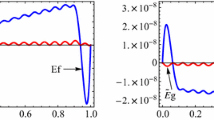Abstract
The aim of this paper is to present spline methods for the numerical solution of integral equations on surfaces of \(\mathbb {R}^3\), by using optimal superconvergent quasi-interpolants defined on type-2 triangulations and based on the Zwart–Powell quadratic box spline. In particular we propose a modified version of the classical collocation method and two spline collocation methods with high order of convergence. We also deal with the problem of approximating the surface. Finally, we study the approximation error of the above methods together with their iterated versions and we provide some numerical tests.
Similar content being viewed by others
Change history
24 July 2017
An erratum to this article has been published.
References
Allouch, C., Sablonnière, P., Sbibih, D.: A collocation method for the numerical solution of a two dimensional integral equation using a quadratic spline quasi-interpolant. Numer. Algorithms 62, 445–468 (2013)
Allouch, C., Sablonnière, P., Sbibih, D.: A modified Kulkarni’s method based on a discrete spline quasi-interpolant. Math. Comput. Simul. 81, 1991–2000 (2011)
Atkinson, K.E.: The Numerical Solution of Integral Equations of the Second Kind. Cambridge University Press, Cambridge (1997)
Barrera, D., Ibáñez, M.J., Sablonnière, P., Sbibih, D.: On near-best discrete quasi-interpolation on a four-directional mesh. J. Comput. Appl. Math. 233, 1470–1477 (2010)
Barrera, D., Ibáñez, M.J.: Bernstein–Bézier representation and near-minimally normed discrete quasi-interpolation operators. Appl. Numer. Math. 58, 59–68 (2008)
de Boor, C., Höllig, K., Riemenschneider, S.: Box Splines. Springer, New York (1993)
Chien, D.: Piecewise polynomial collocation for integral equations with a smooth kernel on surfaces in three dimensions. J. Integral Equ. Appl. 5, 315–344 (1993)
Dagnino, C., Lamberti, P.: Numerical integration of 2-D integrals based on local bivariate \(C^1\) quasi-interpolating splines. Adv. Comput. Math. 8, 19–31 (1998)
Dagnino, C., Lamberti, P.: On the approximation power of bivariate quadratic \(C^1\) splines. J. Comput. Appl. Math. 131, 321–332 (2001)
Dagnino, C., Lamberti, P.: On the construction of local quadratic spline quasi-interpolants on bounded rectangular domains. J. Comput. Appl. Math. 221, 367–375 (2008)
Dagnino, C., Lamberti, P., Remogna, S.: B-spline bases for unequally smooth quadratic spline spaces on non-uniform criss-cross triangulations. Numer. Algorithms 61, 209–222 (2012)
Dagnino, C., Lamberti, P., Remogna, S.: Curve network interpolation by \(C^1\) quadratic B-spline surfaces. Comp. Aided Geom. Des. 40, 26–39 (2015)
Dagnino, C., Remogna, S., Sablonnière, P.: Error bounds on the approximation of functions and partial derivatives by quadratic spline quasi-interpolants on non-uniform criss-cross triangulations of a rectangular domain. BIT Numer. Math. 53, 87–109 (2013)
Lamberti, P.: Numerical integration based on bivariate quadratic spline quasi-interpolants on bounded domains. BIT Numer. Math. 49, 565–588 (2009)
Lyness, J.N., Cools, R.: A Survey of Numerical Cubature over Triangles. Mathematics and Computer Science Division, Argonne National Laboratory, III (1994)
Remogna, S.: Constructing good coefficient functionals for bivariate \(C^1\) quadratic spline quasi-interpolants. In: Daehlen, M., et al. (eds.) Mathematical Methods for Curves and Surfaces. Lecture Notes in Computational Science, vol. 5862, pp. 329–346. Springer, Berlin (2010)
Remogna, S., Sablonnière, P.: On trivariate blending sums of univariate and bivariate quadratic spline quasi-interpolants on bounded domains. Comp. Aided Geometr. Des. 28, 89–101 (2011)
Sablonnière, P.: Quadratic spline quasi-interpolants on bounded domains of \(\mathbb{R}^d, d = 1,2,3\). Rend. Sem. Mat. Univ. Pol. Torino 61, 229–238 (2003)
Wang, R.H.: Multivariate Spline Functions and Their Application. Science Press, Beijing (2001)
Wang, R.H., Li, C.J.: A kind of multivariate NURBS surfaces. J. Comp. Math. 22, 137–144 (2004)
von Winckel, G.: Matlab procedure \(\mathtt{{triquad}}\). http://www.mathworks.com/matlabcentral/fileexchange/9230-gaussian-quadrature-for-triangles
Acknowledgments
This work was supported by the program “Progetti di Ricerca 2016” of the Gruppo Nazionale per il Calcolo Scientifico (GNCS)—INdAM. Moreover, the authors thank the University of Torino for its support to their research.
Author information
Authors and Affiliations
Corresponding author
Additional information
Communicated by Tom Lyche.
An erratum to this article is available at https://doi.org/10.1007/s10543-017-0677-6.
Appendix A
Appendix A
Here we report the expression of the fundamental functions associated with \(Q_{mn}\) defined in (2.1), for \(m,n \ge 8\). They are obtained from the coefficient functionals given in [16]. For the pairs (i, j) with \(i=4,\ldots ,m-3\) and \(j=4,\ldots ,n-3\)
The other \(L_{i,j}\)’s have particular definitions. In the neighbourhood of the point (a, c) we have
Along the lower edge, for \(i=5,\ldots ,m-4\), we have:
and for \(i=4,\ldots ,m-3\):
Taking into account the coefficient functional symmetries, analogous formulas exist for the three other edges and vertices of \(\varOmega \).
We remark that in case \(m,n < 8\) the fundamental functions have particular expressions, always obtained from the coefficient functionals given in [16].
Rights and permissions
About this article
Cite this article
Dagnino, C., Remogna, S. Quasi-interpolation based on the ZP-element for the numerical solution of integral equations on surfaces in \(\mathbb {R}^3\) . Bit Numer Math 57, 329–350 (2017). https://doi.org/10.1007/s10543-016-0633-x
Received:
Accepted:
Published:
Issue Date:
DOI: https://doi.org/10.1007/s10543-016-0633-x




